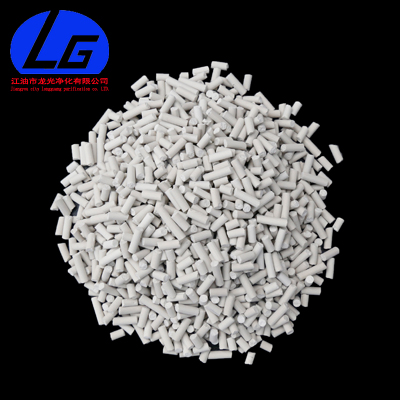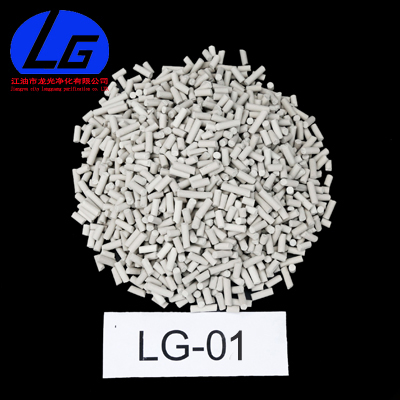Normal packaging:
Woven bag lined with plastic bag. (40kg/bag, 700-900kg/bag)
Other packaging:
Plastic barrels, drums and other packaging can be provided upon request, but a certain packing fee is charged.
Transport storage:
1. During the transportation, it is necessary to ensure that the container does not leak, collapse, fall, and is not damaged. It can not be stored and transported with oxidizer, etc. It should avoid exposure, rain, and high temperature during transportation.
2. Store in a cool, ventilated warehouse. Keep it away from sparks and heat sources. Keep it away from oxidizer, do not store them together. The storage area shall have suitable material holding apparatus to receive leakages.
I. Filling Method
The dust in the desulfurizer should be sieved before loading the furnace. Before filling, check the inside of the tank to see if the internal installation is correct and if the interior is clean. No residual desulfurizer dust is allowed in the tank, otherwise it will be carried into the catalyst layer by the airflow next time.
From the bottom of the desulfurization tank to the tangent line, alumina balls of Φ15 to 20 mm should be installed. The discharge pipe should also be filled with alumina balls. A layer of 8×8 mesh×1.6 mm wire mesh should be placed on the alumina ball and desulfurizer should be installed on the screen. A layer of screen should be placed on the top and pressed with Φ15-20 mm alumina balls. A layer of grating should be pressed on the alumina balls. The desulfurizer discharge pipe should protrude from the upper surface of the lower screen to facilitate unloading the desulfurizer.
Desulfurizers should be loaded on sunny days to avoid moisture. The filling should be as uniform as possible so that fluctuations and drop in pressure and non-uniformity in the air flow distribution are minimized.
The desulfurizer can be sent from the drum to the desulfurization tank by any convenient means, but it should not fall freely from a height of more than 600 mm. Smaller containers can be used to feed desulfurizer from the access hole, or a chute can be placed to connect the cloth bag. The other end of the cloth bag should be placed on the bed. One person should pull the cloth bag in the chute and evenly spread it around. Persons working in the bed should wear dust masks. They should stand on a wooden board to distribute gravity evenly on the desulfurizer. Alumina balls should be lifted by bucket and cannot be slipped with cloth bags. After the desulfurizer is filled and checked, the flange cap screws should be tightened.
II. Start-up Procedure:
1.Desulfurizer dust blowing
In order to remove the dust in the desulfurizer, gas shall be used to blow off the desulfurizer, and the gas may be nitrogen (or air) or feed gas.
2.Gas tightness test and replacement of feed gas system
Airtight tests shall be carried out with air (or nitrogen) and all valves and flanges shall be fully airtight. If air is used for leak testing, after the pressure is relieved, it shall be replaced with feed gas and the system shall be pressurized to the required pressure. Do not use steam as a displacement medium because the condensate will damage the desulfurizer. Temporarily unused valves shall be sealed with baffles.
3.Temperature rising condition
The temperature rising condition of Longguang LG-02 zinc oxide desulfurizer is not very strict. The temperature-raising medium shall be directly heated with inert gas or purified feed gas. If the LG-02 type zinc oxide desulfurizer is used as a desulfurization "gatekeeper" for a low temperature shift catalyst or a methane catalyst, as the zinc oxide has no problem of reduction, the temperature rising speed and the conditions shall be based on the low temperature shift catalyst or the methane catalyst.
III. Stop Procedure
1. Accidental short-term stop
During the stop period, the feed gas must be used to maintain the positive pressure of the desulfurization tank to prevent air or other oxygen-containing gas from entering the desulfurization tank and oxidizing the desulfurizer (be careful to prevent the negative pressure from inhaling air due to the volume contraction of the cooling gas). The next time you start up, you can directly use feed gas to quickly warm up and turn to normal operation.
2. Normal stop for replacing desulfurizer
The desulfurizer to be discharged is reduced or has been vulcanized, and it contacting with air in this state will be oxidized or even spontaneously ignited, resulting in overheating and damage to the equipment. Before unloading the desulfurizer, it is necessary to first cool the desulfurizer with steam (or naturally) to 120~150°C, and then with the nitrogen replacement system, continue cooling to below 60°C. The catalyst unloading chute shall be placed at the discharge outlet of the desulfurization bed, and the hole on the top of the oven shall be opened. The desulfurizer shall be sprayed with water to make it wet. Finally, under the protection of nitrogen, the cover plate of the desulfurizer discharge outlet shall be opened and inner baffle shall be discharged.
When all the desulfurizer is discharged, water shall gradually wash down from the top of the desulfurization tower and the alumina ball shall be completely replaced or washed after sieving and reused. Residues and particles of spent desulfurizers are not allowed in equipment and pipelines.
 Current location:Home - Product Center - Zinc oxide desulfurizer - LG-01 Type Zinc Oxide Desulfurizer
Current location:Home - Product Center - Zinc oxide desulfurizer - LG-01 Type Zinc Oxide Desulfurizer





 Sales hot-line:0816-3736605
Sales hot-line:0816-3736605 E-mail:jysongwei@126.com
E-mail:jysongwei@126.com Address:No. 772, Laojun Road, Jiangyou, Sichuan
Address:No. 772, Laojun Road, Jiangyou, Sichuan

 QQ
QQ Tel
Tel Message
Message Share
Share Top
Top